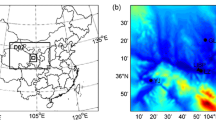Abstract
Real time monitoring, forecasting and modeling air pollutants’ concentrations in major urban centers is one of the top priorities of all local and national authorities globally. This paper studies and analyzes the parameters related to the problem, aiming in the design and development of an effective machine learning model and its corresponding system, capable of forecasting dangerous levels of ozone (O3) concentrations in the city center of Athens and more specifically in the “Athinas” air quality monitoring station. This is a multi parametric case, so an effort has been made to combine a vast number of data vectors from several operational nearby measurements’ stations. The final result was the design and construction of a group of artificial neural networks capable of estimating O3 concentrations in real time mode and also having the capacity of forecasting the same values for future time intervals of 1, 2, 3 and 6 h, respectively.







Similar content being viewed by others
References
Haykin S (1999) Neural networks: a comprehensive foundation. Prentice Hall, USA
Iliadis L (2007) Intelligent information systems and applications in risk estimation. Herodotus Publications, Thessaloniki, Greece
Iliadis L, Spartalis S, Paschalidou A, Kassomenos P (2007) Artificial neural network modeling of the surface ozone concentration. Int J Comput Appl Math 2(2):125–138
Inal F (2010) Artificial neural network prediction of tropospheric ozone concentrations in Istanbul, Turkey. CLEAN Soil Air Water 38(10):897–908
Jones MT (2005) AI application programming, 2nd edn. Charles River Media, Hingham, MA
Kecman V (2001) Learning and soft computing. MIT Press, USA
Ministry of Environment, Energy & Climate Change (2010) Air quality, reports, air pollution 2009 annual report. http://www.ypeka.gr/LinkClick.aspx?fileticket=NIpIqbQg
Ministry of Environment, Energy & Climate Change (2011) Air quality, reports, air pollution 2010 annual report, April 2011. http://www.ypeka.gr/LinkClick.aspx?fileticket=5mmiFX%2b4n2M%3d&tabid=490&language=el-GR
Ministry of Environment, Energy & Climate Change (2012) Air pollution measurements. http://www.ypeka.gr/Default.aspx?tabid=495&language=el-GR. Valid at 15 Apr 2012
Ozcan HK, Bilgili E, Sahin U, Bayat C (2007) Modeling of tropospheric ozone concentrations using genetically trained multi-level cellular neural networks. Adv Atmos Sci 24(5):907–914
Ozdemir H, Demir G, Altay G, Albayrak S, Bayat C (2008) Prediction of tropospheric ozone concentration by employing artificial neural networks. Environ Eng Sci 25(9):1249–1254
Paoli C (2011) A neural network model forecasting for prediction of hourly ozone concentration in Corsica. In: Proceedings IEEE of the 10th international conference on environment and electrical engineering (EEEIC)
Papaleonidas A, Iliadis L (2012a) Employing ANN that estimate ozone in a short-term scale when monitoring stations malfunction. In: Proceedings of the 13th international conference engineering applications of neural networks (EANN 2012), CCIS311, pp 71–80
Papaleonidas A, Iliadis L (2012b) Hybrid and reinforcement multi agent technology for real time air pollution monitoring. In: Proceedings of the 8th IFIP WG12.5 artificial intelligence applications and innovations (AIAI 2012), AICT 381, pp 274–284
Paschalidou A, Iliadis L, Kassomenos P, Bezirtzoglou C (2007) Neural modeling of the tropospheric ozone concentrations in an urban site. In: Proceedings of the 10th international conference engineering applications of neural networks, pp 436–445
Taylor JB (2006) Methods and procedures for the verification and validation of artificial neural networks. Springer Publications, Berlin
Wahab ASA, Al-Alawi SM (2002) Assessment and prediction of tropospheric ozone concentration levels using artificial neural networks. Environ Model Softw 17:219–228
Author information
Authors and Affiliations
Corresponding author
Rights and permissions
About this article
Cite this article
Papaleonidas, A., Iliadis, L. Neurocomputing techniques to dynamically forecast spatiotemporal air pollution data. Evolving Systems 4, 221–233 (2013). https://doi.org/10.1007/s12530-013-9078-5
Received:
Accepted:
Published:
Issue Date:
DOI: https://doi.org/10.1007/s12530-013-9078-5




